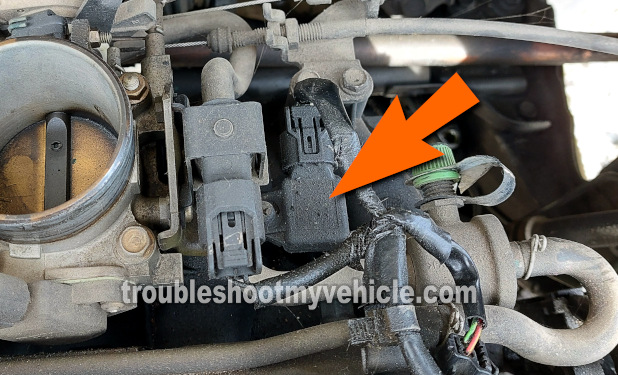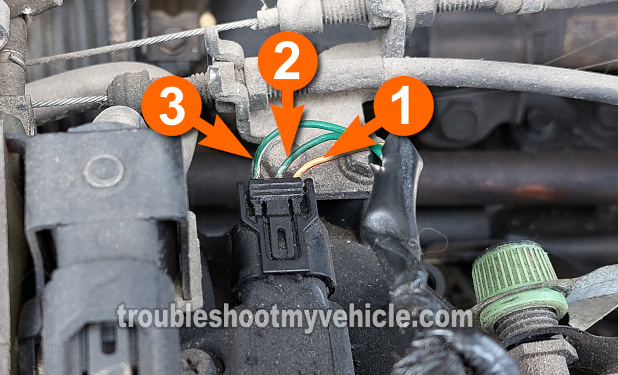
You can quickly and easily test the manifold absolute pressure (MAP) sensor with a multimeter, and in this tutorial, I'll show you how.
With your test results, you'll easily determine if the MAP sensor is good or bad on your 2001-2005 1.7L Honda Civic.
Contents of this tutorial:
- Symptoms Of A Bad MAP Sensor.
- Where To Buy The MAP Sensor And Save.
- MAP Sensor Circuit Descriptions.
- TEST 1: Testing The MAP Sensor Signal.
- TEST 2: Making Sure The MAP Sensor Is Getting 5 Volts.
- TEST 3: Making Sure The MAP Sensor Is Getting Ground.
- MAP Sensor Code Won't Go Away.
- More 1.7L Honda Civic Tutorials.
APPLIES TO: This tutorial applies to the following vehicles:
- 1.7L Honda Civic DX: 2001, 2002, 2003, 2004, 2005.
- 1.7L Honda Civic EX: 2001, 2002, 2003, 2004, 2005.
- 1.7L Honda Civic GX: 2001, 2002, 2003, 2004, 2005.
- 1.7L Honda Civic HX: 2001, 2002, 2003, 2004, 2005.
- 1.7L Honda Civic LX: 2001, 2002, 2003, 2004, 2005.
TPS SENSOR DIAGNOSTIC TESTS:
Symptoms Of A Bad MAP Sensor
The MAP sensor is a critical component of the engine management system, and as such, when it fails, the check engine light will be illuminated. Not only that, but engine performance will suffer.
You'll see one or more of the following trouble codes:
- P0107: MAP Sensor Circuit Low Voltage.
- P0108: MAP Sensor Circuit High Voltage.
- P1128: MAP Sensor Signal Lower Than Expected.
- P1129: MAP Sensor Signal Higher Than Expected.
You'll also see one or more of the following symptoms:
- The engine won't start.
- The engine takes a long time to start (extended cranking time).
- Black smoke coming out of the tailpipe.
- Bad gas mileage.
- The engine idles rough when running.
- A lack of power when under load.
You can learn more about the MAP sensor here: What Does The MAP Sensor Do? (1.7L Honda Civic).
Where To Buy The MAP Sensor And Save
The following links will help you comparison shop for the manifold absolute pressure (MAP) sensor. All of the recommended MAP sensors are of known automotive brands -no knockoff MAP sensors!
Disclosure: As an Amazon Associate, I earn from qualifying purchases. If my tutorials help you, using these links is an easy way to support the site at no extra cost to you. Thank you!
Not sure if the MAP sensor fits your particular 1.7L Honda Civic? Don't worry, once you get to the site they'll make sure it fits by asking you the specifics of your particular Civic. If it doesn't fit, they'll find you the right MAP sensor.
MAP Sensor Circuit Descriptions

| Wire | Color | Description |
|---|---|---|
| 1 | Yellow with red stripe (YEL/RED) | 5 Volts DC |
| 2 | Green with red stripe (GRN/RED) | MAP signal |
| 3 | Green with white stripe (GRN/WHT) | Ground |
TEST 1: Testing The MAP Sensor Signal

As you're probably already aware, the manifold absolute pressure (MAP) sensor's voltage signal reacts to the vacuum pressure that's applied to the sensor.
In a nutshell, the MAP sensor's voltage signal decreases/increases as vacuum is applied/released to it.
If the MAP sensor is bad, it'll stay stuck, producing one voltage value as you apply/release vacuum to it.
The cool thing is you can easily test the MAP sensor's voltage signal output, and that's what you'll do in this test section.
NOTE: If you don't have a vacuum pump, don't worry. You can use your mouth to apply vacuum to the MAP sensor.
IMPORTANT: The MAP sensor must remain connected to its electrical connector to read the voltage within its signal wire. You'll need to use a back probe on the connector or a wire piercing probe on wire. This is the tool I use: Goupchn 4mm Banana to Banana Plug Test Leads Kit (Amazon affiliate link).
OK, these are the test steps:
- 1
Remove the MAP sensor from its place on the intake manifold.
- 2
If you had to disconnect the MAP sensor from its electrical connector to remove it, reconnect it to the connector now.
- 3
Connect your vacuum pump to the MAP sensor's vacuum inlet.
You'll need to use a piece of vacuum hose to connect the vacuum pump to the MAP sensor. - 4
Place your multimeter in Volts DC mode.
- 5
Connect the red multimeter probe to the wire labeled with the number 2 (in the image above).
The wire labeled with the number 2 is the green with red stripe (GRN/RED) wire of the connector.
IMPORTANT: The MAP sensor must remain connected to its 3-wire connector. - 6
Connect the black multimeter test lead directly to the battery negative (-) terminal.
- 7
Turn the key ON but don't start the engine.
- 8
At this point your multimeter should register a value around 4.5 Volts DC.
- 9
Now, pump the vacuum pump to apply vacuum to the MAP sensor. The voltage should decrease.
- 10
Release the vacuum you applied to the MAP sensor. The voltage should increase.
OK, let's examine your test results:
CASE 1: The MAP voltage signal decreased/increased as you applied/released vacuum to the sensor. This test result confirms that the MAP sensor is functioning correctly.
Now, if the check engine light keeps illuminating with a MAP sensor diagnostic trouble code, take a look at the section: MAP Sensor Code Won't Go Away for more info.
CASE 2: The MAP voltage signal DID NOT increase/decrease as you applied/released vacuum. This test result usually tells you that the MAP sensor is defective.
To be absolutely sure the MAP sensor is bad, make sure that it's getting both power and Ground. Go to the next test: TEST 2: Making Sure The MAP Sensor Is Getting 5 Volts.
CASE 3: Your multimeter registered 0 Volts. This test result usually means that the MAP sensor is bad but not always.
There's a good chance that the MAP sensor is not getting power or Ground. So the next step is to make sure that the MAP sensor is getting five votes from the fuel injection computer. Go to: TEST 2: Making Sure The MAP Sensor Is Getting 5 Volts.
TEST 2: Making Sure The MAP Sensor Is Getting 5 Volts

If you've reached this point, there's a good chance that the MAP sensor isn't getting power (5 Volts DC).
The yellow with red stripe (YEL/RED) wire delivers these 5 Volts to the MAP sensor, and in the photo above, I've labeled it with the number 1.
In this test section, you'll confirm that the YEL/RED wire delivers 5 Volts DC to the MAP sensor.
CAUTION: If you probe the front of the connector, be careful not to damage the metal female terminal. If the terminal gets damaged, you'll need to replace the connector.
Let's get started:
- 1
Place your multimeter still in Volts DC mode.
- 2
Disconnect the MAP sensor from its electrical connector.
- 3
Probe the wire labeled with the number 1, in the photo above, with the red multimeter test lead.
The wire labeled with the number 1, in the photo above, is the YEL/RED of the connector. - 4
Now Ground the black multimeter test lead on the battery's negative (-) post.
- 5
Turn the key ON but don't start the engine.
- 6
Your multimeter should show you a voltage value around 4.5 to 5 Volts DC.
OK, let's take a look at what your results mean:
CASE 1: The multimeter registered 5 Volts. This is the correct and expected test result.
Now that you've confirmed the MAP sensor is getting power, your next test is to make sure that it's getting Ground. Go to: TEST 3: Making Sure The MAP Sensor Is Getting Ground.
CASE 2: The multimeter DID NOT register 5 Volts. Without 5 Volts, the MAP sensor will not function.
Although it's beyond the scope of this tutorial to troubleshoot the cause of these missing 5 Volts, you have now eliminated the MAP sensor itself as bad.
The most likely cause of these missing 5 Volts is an open-circuit problem in the wire between the MAP sensor and the fuel injection connector.
TEST 3: Making Sure The MAP Sensor Is Getting Ground

So far, you have confirmed the following:
- The MAP sensor's voltage signal does not decrease/increase as you apply/release vacuum (TEST 1).
- The MAP sensor is receiving 5 Volts DC (TEST 2).
Your last test is to see if the MAP sensor is receiving Ground.
The wire that delivers Ground to the MAP sensor is the green with white stripe (GRN/WHT) wire of the connector.
In the photo above, I've labeled the GRN/WHT wire with the number 3.
CAUTION: If you probe the front of the connector, be careful not to damage the metal female terminal. If the terminal gets damaged, you'll need to replace the connector.
IMPORTANT: The fuel injection computer supplies Ground to the MAP sensor. Be careful and do not apply battery 12 Volts to this wire, or you'll fry the computer. The multimeter voltage test indicated in the test instructions is a safe way to test for the presence of Ground in the wire.
These are the test steps:
- 1
Place your multimeter still in Volts DC mode.
- 2
Disconnect the MAP sensor from its electrical connector.
- 3
Probe the wire labeled with the number 3 in the image above, with the black multimeter test lead.
The wire labeled with the number 3 is the GRN/WHT wire of the connector. - 4
Connect the red multimeter test lead on the battery's positive (+) post.
- 5
Turn the key ON but don't start the engine.
- 6
Your multimeter register 10 to 12 Volts DC.
OK, let's interpret your test result:
CASE 1: The multimeter registered 10 to 12 Volts. This is the correct and expected test result. This test result confirms that the MAP sensor is getting Ground.
You can conclude the MAP sensor is bad and needs replacement if you have:
- Confirmed that the MAP sensor's voltage signal does not decrease/increase as you apply/release vacuum to the sensor (TEST 1).
- Confirmed that the MAP sensor is receiving 5 Volts DC (TEST 2).
- Confirmed in this test section that it's receiving Ground.
CASE 2: The multimeter DID NOT register 10 to 12 Volts. This test result tells you that the MAP sensor is not receiving Ground. Without Ground the MAP sensor will not function.
With this test result you can eliminate the MAP sensor itself as bad. Your next step is to find out why this Ground is missing and resolve the problem.
The most likely cause of this missing Ground is an open-circuit problem in the wire between the MAP sensor connector and the fuel injection connector.
MAP Sensor Code Won't Go Away
In some cases, a MAP sensor trouble code keeps returning and illuminating the check engine light after replacing the MAP sensor with a new one or after testing it (and confirming the sensor is functioning correctly).
If this is happening in your case, then one or more of the following problems could be behind the issue:
- The o-ring on the vacuum inlet of the MAP sensor is missing or cracked.
- The engine has several cylinders with very low engine compression causing it to idle rough and thus producing low or erratic vacuum. For this I suggest an engine compression test.
- The MAP sensor is failing intermittently. Which means that it works fine most of the time, but every now and then it doesn't:
- I have found that the best way to test these intermittent problems is to slightly tap the MAP sensor with the handle of a screw-driver and see if this tapping screws up the voltage readings as I apply vacuum.
- The MAP sensor's connector is bad, usually the locking tab is broken and the connector has worked itself loose, causing an intermittent false connection.
- Your fuel pump is starting to go bad and is not sending enough fuel and/or fuel pressure up to the fuel injectors. I suggest a fuel pump test.
More 1.7L Honda Civic Tutorials
You can find a complete list of 1.7L Honda Civic tutorials in this index:
Here's a small sample of the tutorials you'll find in the index:
- How To Test The Crank Sensor (2001-2005 1.7L Honda Civic).
- Maintenance Required Light Reset (2001-2005 1.7L Honda Civic).
- How To Do A Cylinder Balance Test (2001-2005 1.7L Honda Civic).
- How To Test The TP Sensor (2001-2005 1.7L Honda Civic).

If this info saved the day, buy me a beer!




